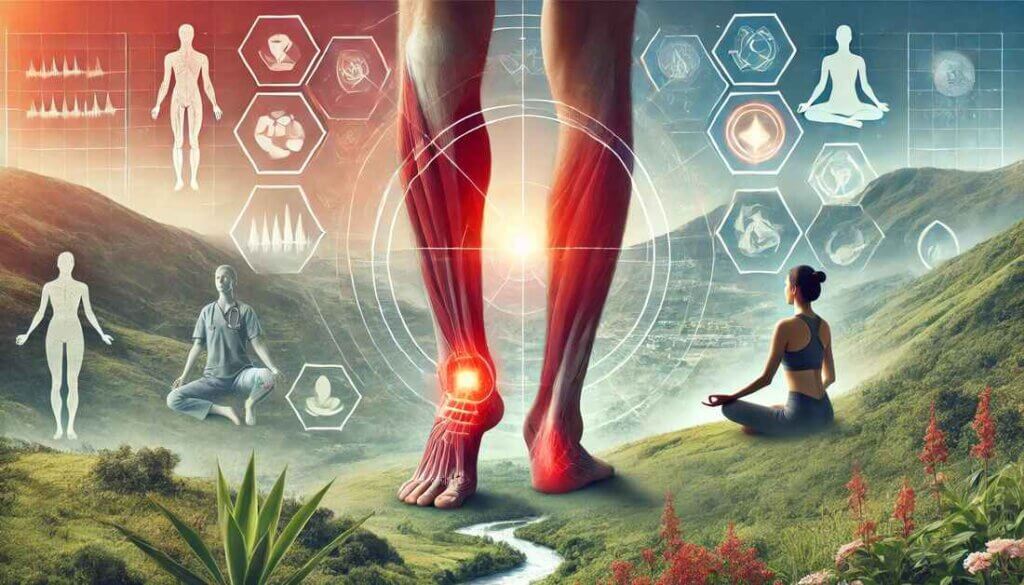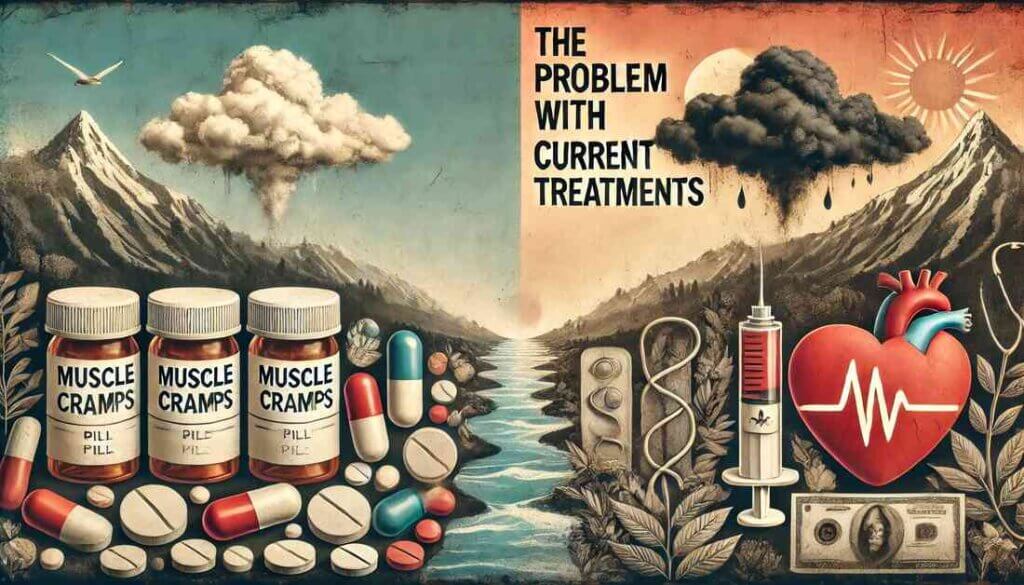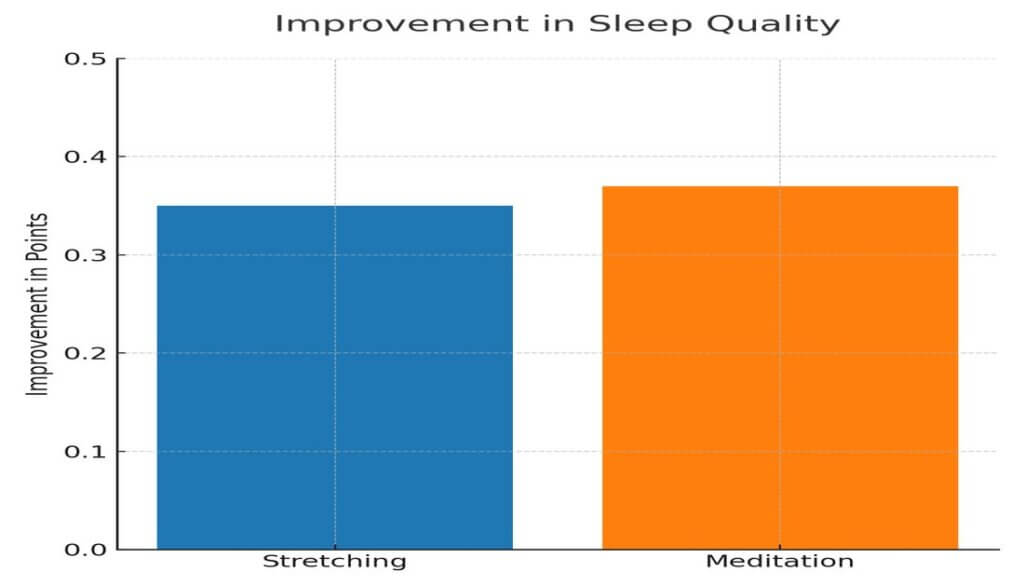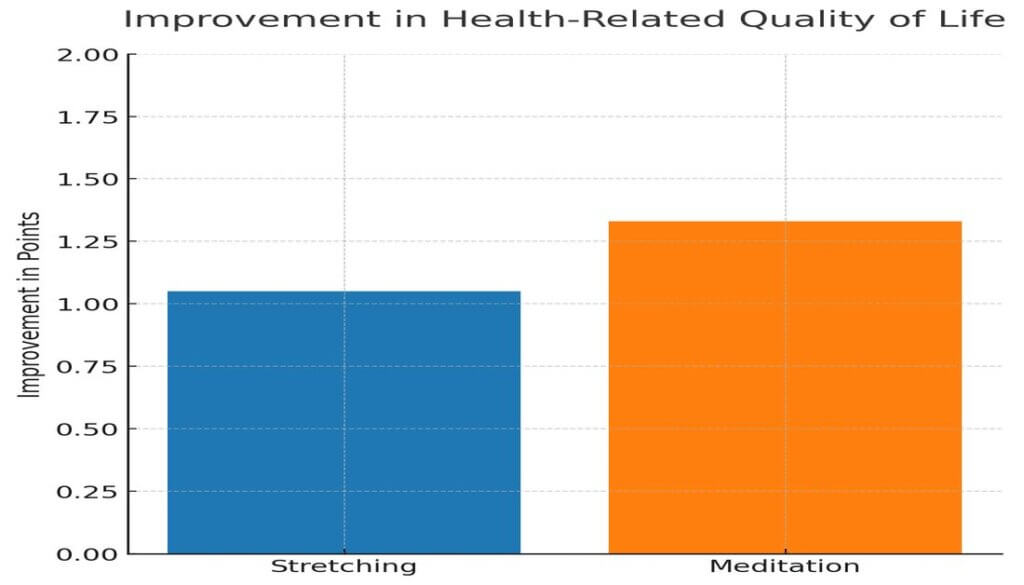Stretching Vs Meditation.
| S.no | Aspect | Stretching | Meditation |
| 1 | Reduction in Cramp Severity | Reduces cramp severity by 1.44 points on a 10-point VAS scale. This is significant relief, though slightly less effective than meditation. | Reduces cramp severity by 1.97 points on a 10-point VAS scale, offering slightly more relief than stretching. |
| 2 | Improvement in Sleep Quality | Improves sleep quality by 0.35 points, helping patients fall asleep faster and experience fewer disturbances. | Improves sleep quality by 0.37 points, aiding in better sleep continuity and quality. |
| 3 | Improvement in Health-Related Quality of Life | Increases HRQOL by 1.05 points, indicating a positive impact on overall well-being, though not as much as meditation. | Increases HRQOL by 1.33 points, showing a broader positive effect on overall health and life satisfaction. |
| 4 | Ease of Practice | Requires physical movement and some practice to perform correctly, which may not be ideal for those with limited mobility. | Can be done anywhere with minimal guidance, making it more accessible for individuals regardless of their physical condition. |
| 5 | Potential Side Effects | Possible discomfort or minor injury if not done properly, especially in individuals with existing physical limitations. | Rare side effects, primarily psychological if any, such as mild frustration for beginners who find it difficult to focus. |
| 6 | Accessibility | May require specific physical capability, and sometimes equipment like mats or stretching bands to perform exercises correctly. | Highly accessible, requiring no special equipment or physical capability, making it an ideal option for most people. |
Those painful nocturnal muscle cramps are more than just bothersome. They significantly impair the quality of life in cirrhotic patients by eroding hours of sleep, limiting mobility, and causing severe pain.
You’re not alone if you’ve experienced this phenomenon: nearly two-thirds of those with cirrhosis report suffering from frequent night-time muscle cramps.
With the absence of effective, safe and affordable treatment, this search for treatment has been a challenge, but some good news has come through a recent study.
A New Approach to Muscle Cramp Relief

In the march to find better treatments, one new recent study published in Liver International tested two non-drug approaches: stretching and meditation.
The study, called the RELAX trial, asked if these simple, Non-invasive methods might offer some much-needed relief for cirrhosis patients who often struggle with nighttime muscle cramps.
In a recent study, adults with cirrhosis who had experienced at least four muscle cramps in the past month were divided into two groups.
One group followed a nightly stretching routine, while the other spent 10 minutes practicing guided meditation before bed.
Over the course of 28 days, researchers monitored both groups to see how these simple practices affected cramp severity, sleep quality, and overall well-being.
The Problem with Current Treatments

Current treatments for muscle cramps often leave much to be desired. Medications like quinidine, while effective, come with serious risks, such as potential cardiotoxicity.
When it comes to treating muscle cramps, especially for those battling cirrhosis, the options on the table often come with significant downsides.
Let’s take a closer look at the challenges tied to some of the most commonly used treatments.
1. Quinidine: Effective but Risky
Quinidine is a go-to prescription for muscle cramps because it can effectively reduce their frequency and severity. However, this solution isn’t without its dangers. Quinidine carries the risk of cardiotoxicity, which can lead to serious heart-related side effects.
For someone already managing a chronic condition like cirrhosis, adding heart complications to the mix can be a particularly hazardous gamble.
2. Albumin Infusion: High Cost, High Risk
Albumin infusions are another treatment frequently recommended for cirrhosis patients. While albumin can help lessen cramps, it also carries the risk of volume overload—a condition where excess fluid accumulates in the body.
This can result in swelling, high blood pressure, and potentially serious heart issues. On top of that, albumin infusions don’t come cheap, making them a costly and sometimes unsustainable option for many patients over the long haul.
3. Taurine: Effective but Expensive and Unregulated
Taurine, an amino acid, has shown promise in reducing muscle cramps. But there’s a catch—it’s often pricey and not well-regulated.
This lack of regulation raises red flags about the quality and consistency of taurine supplements, which could put patients at risk if they’re relying on subpar products.
4. Magnesium: Common but Ineffective
Magnesium is frequently recommended to combat muscle cramps, but research suggests it often falls short.
Many patients who turn to magnesium may not experience the relief they’re hoping for, leading to continued discomfort and frustration as their cramps persist.
5. General Drawbacks: Side Effects and Limited Accessibility
Beyond the specific issues with each treatment, many traditional options come with general drawbacks, like side effects that can worsen a patient’s overall health.
Moreover, the high costs and potential risks associated with these treatments can make them less accessible or appealing for long-term use.
Study Findings: Stretching and Meditation Both Show Promise
Reduction in Cramp severity

The diagram shows the average reduction in muscle cramp severity for cirrhosis patients who took part in the RELAX trial.
Both stretching and meditation led to noticeable decreases in cramp severity, with meditation showing a slightly higher reduction of 1.97 points, compared to 1.44 points for stretching.
This indicates that while both interventions are effective, meditation might offer a slight edge in reducing cramp severity.
Improvement in Sleep Quality

This diagram illustrates the improvement in sleep quality for participants in both the stretching and meditation groups. Although the changes were modest—0.35 points for stretching and 0.37 points for meditation—they were positive across the board.
The similarity in these results suggests that both practices can contribute to better sleep, which is vital for overall health and well-being.
Improvement in Health-Related Quality of Life

The diagram also highlights the improvements in health-related quality of life (HRQOL) as reported by study participants.
Meditation led to a slightly higher improvement of 1.33 points, compared to 1.05 points for stretching.
This suggests that meditation might not only help in reducing cramp severity but could also have a more significant positive impact on overall health and well-being than stretching.
Why Meditation Might Help

Meditation has earned its reputation for offering a range of mental and physical benefits. When it comes to managing muscle cramps in cirrhosis patients, meditation brings several advantages that make it a powerful tool.
Here’s a closer look at how meditation can help, broken down into five key areas:
1. Reducing Stress and Anxiety
One of meditation’s greatest strengths is its ability to lower stress and anxiety levels. Chronic stress often leads to muscle tension, which can trigger or worsen muscle cramps.
By calming the mind and easing stress, meditation helps relax the body, reducing the chance of cramps.
For cirrhosis patients, who frequently experience significant stress due to their condition, this stress-relieving aspect of meditation is particularly beneficial.
2. Improving Sleep Quality
Sleep problems are common among people with cirrhosis, and they’re often made worse by nighttime muscle cramps.
Meditation, especially mindfulness practices, has been shown to improve sleep quality by promoting relaxation and helping the mind release the day’s worries.
Better sleep can break the cycle of poor rest and cramp aggravation, leading to overall better health.
3. Enhancing Mind-Body Awareness
Meditation often emphasizes a deep connection between the mind and body, teaching individuals to pay closer attention to their physical sensations and mental states.
This increased awareness can help patients notice early signs of muscle tension or stress that might lead to cramps.
With this awareness, they can take proactive steps, like stretching or changing their posture, to prevent cramps before they start.
4. Promoting Relaxation and Muscle Relaxation
The relaxation that comes from meditation isn’t just mental—it’s physical too. Techniques like progressive muscle relaxation, often used in meditation, can directly target muscles that are prone to cramping.
By regularly practicing these relaxation techniques, patients can reduce overall muscle tension, which helps decrease the frequency and severity of cramps.
5. Supporting Holistic Health and Well-being
Meditation contributes to a holistic sense of well-being, going beyond just physical benefits. It can boost mood, increase resilience, and give patients a greater sense of control over their health.
For cirrhosis patients, who may feel overwhelmed by their condition, meditation offers a non-invasive, empowering way to improve their quality of life.
This broader impact on well-being can make managing symptoms like muscle cramps less stressful and more manageable.
Integrating Meditation into Daily Life

If you want to include meditation in your daily life, the first thing you should do is talk to your doctor about it.
This is important because everyone’s body and needs are different. After that, it’s best to learn meditation from a certified and experienced instructor—someone who knows a lot about meditation and has been practicing it for many years.
These days, I’ve noticed that many people try to learn meditation by watching YouTube videos or reading books.
But from my 15 years of experience with meditation, I can tell you that this isn’t the best way. You really need a proper trainer or coach to guide you, especially if you can afford to pay for their help.
If paying for a coach isn’t an option, don’t worry. There are many places where you can learn meditation for free. Just find one of these free programs and practice regularly.
Remember, you’ll only get the benefits of meditation if you learn it correctly. Otherwise, you might not see any results, and you could lose faith in meditation.
Everyone’s lifestyle and body are different. So, instead of copying what someone else does, it’s important to learn meditation in a way that suits you best.
As I mentioned, start by talking to your doctor and then find a good instructor. That’s the best way to get real benefits from meditation.
Conclusion [ Stretching vs Meditation ]
I hope you liked this blog post, where I talked about how stretching and meditation can help relieve your nighttime muscle cramps.
If you found this post helpful, I encourage you to check out my other blog posts too. I’ve discussed different aspects of meditation there, which might be useful for you.
Finally, I want to share some good news from The RELAX trial: simple habits like stretching and meditation could help ease those annoying nighttime muscle cramps, especially if you have cirrhosis.
While they aren’t magic cures, these practices offer a safe and easy way to manage a common and painful problem.
Whether you choose to stretch, meditate, or do both, these methods could help you sleep better, reduce your pain, and improve your overall health.
If muscle cramps or other symptoms of cirrhosis have been bothering you, why not try stretching or meditation?
They’re easy to start, don’t need any special equipment, and might just make a big difference in how you feel.
Have you tried stretching or meditation for muscle cramps before? We’d love to hear about your experiences in the comments!
And if you’re just starting out, keep us posted on how it goes—your story might just encourage someone else to find their own relief.
To read my other blogs: Click here